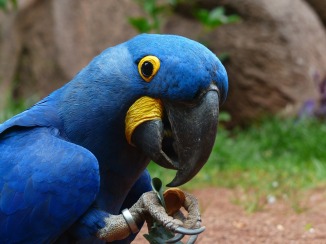January is National Train Your Dog Month
…but it should be National Train Your PET Month!

All pets can be trained. While some don’t need it as much as others, training is a great way to spend quality time with your bird, rabbit, guinea pig…you name it. If you don’t think your pet can be trained, just take a look on youtube and see what other enterprising people have been doing.
Why Train Birds

Birds really respond well to training for a number of reasons. They are incredibly smart so, first of all, we train them no matter what we are doing. Just like a small child who learns by watching. I recommend working to learn how to train your bird…so you get them to actually do what you want (not what you do). There are a number of basics that all birds should learn – step up on command to all members of the family, step up on command to confident strangers and stay on a perch.
Why those three?
First, we want our birds to be member’s of our family flock and to discourage pair bonding with one individual. In addition to worrying about reproductive health issues or aggression to perceived interlopers, just think how unhappy you’d be if your preferred mate never gave you what you wanted. It’s just not very nice.
Second, we want our birds to learn to interact with a variety of people, to be confident and assured of themselves. Working on this step helps broaden their horizons and allows owners to worry less about strangers.
Finally, birds expect to spend most of their time with their flock. Since most of us work away from home we can’t give that to them. When we are home, we can allow our birds to “flock” with us to different rooms if they are able to stay on a perch. I feel it also reinforces the idea of independent play. Imagine a 3 yr old child who has to be held by mom or dad at all times – kind of tiring and perhaps a bit unhealthy.
On top of that, there is one more basic. I think it is extremely important…teach your bird to take medicine from a syringe! This can only be done when they are healthy but the rewards you will reap if you ever have to treat your feathered friend are endless.
Think your bird is too old? Check out this video of a 50 year old Amazon taking her “treats”. Miss Gregory Gets Her Meds











 We all fear accidents – all we can’t do is take reasonable precations. But our pets sometimes outwit us and late last night Jasper flew into a pot of boiling water. When I saw him the next day I explained to the owner that even though the legs looked pretty good, the true extent of the damage might not show up for several days.
We all fear accidents – all we can’t do is take reasonable precations. But our pets sometimes outwit us and late last night Jasper flew into a pot of boiling water. When I saw him the next day I explained to the owner that even though the legs looked pretty good, the true extent of the damage might not show up for several days.





